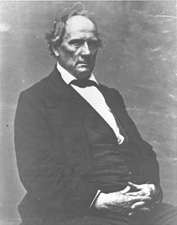Charles Tillinghast James
| Charles Tillinghast James | |
|---|---|
 | |
| United States Senator from Rhode Island | |
|
In office March 4, 1851 – March 4, 1857 | |
| Preceded by | Albert C. Greene |
| Succeeded by | James F. Simmons |
| Personal details | |
| Born |
September 15, 1805 West Greenwich, Rhode Island, US |
| Died |
October 17, 1862 (aged 57) Sag Harbor, New York, US |
| Resting place | Swan Point Cemetery |
| Political party | Democratic |
| Spouse(s) | Lucinda James |
| Profession | Politician |
Charles Tillinghast James (September 15, 1805 – October 17, 1862) famous consulting mechanical engineer, early proponent of the steam mill, and United States Democratic Senator from the state of Rhode Island from 1851 to 1857.
Education and early experience
Charles T. James was born in West Greenwich, Rhode Island. He had a largely self-taught knowledge of mathematics and mechanics. In the early 1830s he was working in small mills in the Quinebaug Valley of Connecticut and later he was supervising the startup of machinery in mills in the Providence area. His reputation had grown such that by 1834 Samuel Slater brought him to Providence to overhaul the first large American steam powered mill at the Steam Cotton Manufacturing Company which was built in 1828. This work made him realize the potential of steam mills and he became the leading advocate of steam mills and a pioneer engineer and promoter of coastal and Southern steam mills.
Mechanical engineering career
James, an avid coffee drinker, did a good business designing and promoting steam mills to small seaport towns which did not have any experience with mills and needed his expertise to advise on which equipment to buy and how to design the entire factory. James knew all the best equipment and their manufacturers and selected the pickers, breaker cards, drawing heads, Providence Machine fly frames, Mason finished cards, spinning equipment looms and steam engines from Providence's India Point Works run by Fairbanks, Bancroft and Company and later by Corliss, Nightengale and Company.
James promoted steam mills in seaports that had seen a great reduction in business because of the centralization of trade in bigger ports such as Boston due to the centralizing technology of the Middlesex Canal, the railroads, and bigger ships. These "decayed" smaller seaports such as Newburyport and Salem would be able to get coal and cotton supplies directly from the ships and export their steam mill products directly by ship again.
Between 1839-1846 Charle T. James owned the southern half of the Brewster-Coffin House (High St.) in Newburyport, Massachusetts.[1] During this time he worked on several steam mill projects in the area These included the Bartlett, James, and Globe(later called Peabody) Mills in Newburyport.
Steam Mills promoted by Charles T. James include the Barlett Mill, and later the James Steam Mill (built in 1843 with 17,000 spindles) and the Globe steam Mill (built in 1846 with 12,200 spindles) in Newburyport, Massachusetts; mills in Portsmouth NH 1845-6. Naumkeag Steam Cotton Mill built in 1845-46 in Salem, Massachusetts. Also the Essex steam mill; the Conestoga Steam Mill in Lancaster, Pennsylvania in 1844-45. Later he was closely involved with the Graniteville Mill in South Carolina with William Gregg.
Civil War and death
James developed an early rifled projectile and rifling system for artillery. James rifles and projectiles were used in the American Civil War. The greatest triumph of his system was the breaching of Fort Pulaski.
During the demonstration of a projectile at Sag Harbor, Long Island, New York, a worker attempted to remove a cap from a shell. It exploded killing the man and mortally wounding James, who died the next day.[2]
 Two Model 1829 32-pounder siege and garrison guns, rifled by the James method(64-pdr James rifles). The one in the foreground is on a siege carriage. The one behind is on an iron, front pintle, barbette carriage.
Two Model 1829 32-pounder siege and garrison guns, rifled by the James method(64-pdr James rifles). The one in the foreground is on a siege carriage. The one behind is on an iron, front pintle, barbette carriage. A James pattern solid shot. The “birdcage” at the base would have been covered by sheet lead which, upon firing the gun, would have expanded into the grooves of the rifling.
A James pattern solid shot. The “birdcage” at the base would have been covered by sheet lead which, upon firing the gun, would have expanded into the grooves of the rifling.
References
- ↑ Old Newburyport Houses By Albert Hale, published 1912, page 40.
- ↑ Dickey, p. 147
- Taunton and Mason: Cotton Machinery and Locomotive Manufacture in Taunton, Massachusetts, 1811–1861, by John William Lozier, Ph.d Dissertation Thesis at Ohio State University 1978. Charles T. James section pages 375-386. Copies also at Old Colony Historical Society in Taunton and at The Baker Business School Library at Harvard University.
- Dickey, Thomas S. and George, Peter C., Field Artillery Projectiles of the American Civil War, Atlanta, GA: Arsenal Press, 1980.
- Letters on the Culture and Manufacture on Cotton. By Charles Tillinghast James, published 1850. Originally published in:
- Hunt's Merchants' Magazine and Commercial Review By Thomas Prentice Kettell, volume 22 January–June 1850 pages 290-311. Article IV by Charles T. James entitled Culture and Manufacture of Cotton which rebuts an article by Amos Adams Lawrence.
External links
- United States Congress. "Charles Tillinghast James (id: J000046)". Biographical Directory of the United States Congress.
- Charles T. James at Find A Grave
- Civil War Artillery Projectiles
| United States Senate | ||
|---|---|---|
| Preceded by Albert C. Greene |
U.S. Senator (Class 1) from Rhode Island March 4, 1851 – March 4, 1857 Served alongside: John H. Clarke and Philip Allen |
Succeeded by James F. Simmons |
